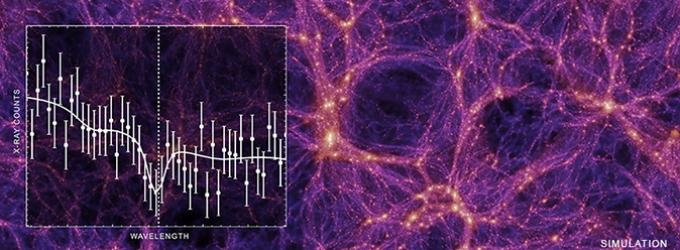
Help EarthSky keep going! Please donate what you can to our once-yearly crowd-funding campaign.
You might know that much of our universe is thought to exist in the form of dark matter and dark energy, both of which are still exceedingly mysterious. But that’s not what this story is about. It’s about another question about the mass, or matter, of our universe that’s also puzzled astronomers for decades. That is, about a third of the “normal” matter in the universe – hydrogen, helium and other ordinary elements, created in the first billion years or so after the Big Bang – have been missing. Now, however, new results from the Chandra X-ray Observatory might have helped locate this elusive expanse of missing matter in giant strands of gas in intergalactic space known to astronomers as the WHIM.
NASA explained in a statement on February 14, 2019:
From independent, well-established observations, scientists have confidently calculated how much normal matter — meaning hydrogen, helium and other elements — existed just after the Big Bang. In the time between the first few minutes and the first billion years or so, much of the normal matter made its way into cosmic dust, gas and objects such as stars and planets that telescopes can see in the present-day universe.
The problem is that when astronomers add up the mass of all the normal matter in the present-day universe about a third of it can’t be found …
One idea has been that this missing normal matter gathered into gigantic strands or filaments of warm and hot gas in intergalactic space. These filaments are known to astronomers as the warm-hot intergalactic medium, or WHIM. The gas filaments are invisible to telescopes that see in visible light, but some of the warm gas in the filaments has been detected in ultraviolet light.
Now, using a new technique, researchers have found new and strong evidence for the hot component of the WHIM based on data from Chandra and other telescopes. Orsolya Kovacs of the Harvard-Smithsonian Center for Astrophysics (CfA) is the lead author of the new study, which was published in The Astrophysical Journal on February 13. She said in a statement:
If we find this missing [matter], we can solve one of the biggest conundrums in astrophysics. Where did the universe stash so much of its matter that makes up stuff like stars and planets and us?
These astronomers used Chandra to look for and study the gas filaments lying along the path to a distant quasar. This particular quasar is located about 3.5 billion light-years from Earth, and it also emits X-rays. The astronomers were looking to see if the quasar’s light had been absorbed by the WHIM. A statement from the Harvard-Smithsonian Center for Astrophysics explained:
One of the challenges of this method is that the signal of absorption by the warm-hot intergalactic medium [WHIM] is weak compared to the total amount of X-rays coming from the quasar. When searching the entire spectrum of X-rays at different wavelengths, it is difficult to distinguish such weak absorption features – actual signals of the warm-hot intergalactic medium – from random fluctuations.
Kovacs and her team overcame this problem by focusing their search only on certain parts of the X-ray light spectrum, reducing the likelihood of false positives. They did this by first identifying galaxies near the line of sight to the quasar that are located at the same distance from Earth as regions of warm gas detected from ultraviolet data. With this technique they identified 17 possible filaments between the quasar and us, and obtained their distances.
Because of the expansion of the universe, which stretches out light as it travels, any absorption of X-rays by matter in these filaments will be shifted to redder wavelengths. The amounts of the shifts depend on the known distances to the filament, so the team knew where to search in the spectrum for absorption from the warm-hot intergalactic medium.
Akos Bogdan, also from the Harvard-Smithsonian Center for Astrophysics, is a study co-author. Bogdan said:
Our technique is similar in principle to how you might conduct an efficient search for animals in the vast plains of Africa. We know that animals need to drink, so it makes sense to search around watering holes first.
Read more about this study via NASA or CfA.
Bottom line: Astronomers have been unable to account for about a third of the normal mass created in the first billion years after the Big Bang. A new study suggests it might be hiding in gigantic strands of gas in intergalactic space, known as the WHIM.
Source: Detection of the Missing Baryons toward the Sightline of H1821+643











